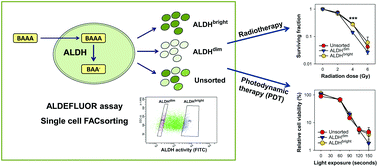High aldehyde dehydrogenase activity does not protect colon cancer cells against TPCS2a-sensitized photokilling
Abstract
Aldehyde dehydrogenases (ALDH) are detoxifying enzymes that are upregulated in cancer stem cells (CSCs) and may cause chemo- and ionizing radiation (IR) therapy resistance. By using the ALDEFLUOR assay, CD133 + human colon cancer cells HT-29, were FACSorted into three populations: ALDHbright, ALDHdim and unsorted (bulk) and treated with chemo-, radio- or photodynamic therapy (PDT) using the clinical relevant photosensitizer disulfonated tetraphenyl chlorin (TPCS2a/fimaporfin). Here we show that there is no difference in cytotoxic responses to TPCS2a-PDT in ALHDbright, ALDHdim or bulk cancer cells. Likewise, both 5-FU and oxaliplatin chemotherapy efficacy was not reduced in ALDHbright as compared to ALDHdim cancer cells. However, we found that ALHDbright HT-29 cells are significantly less sensitive to ionizing radiation compared to ALDHdim cells. This study demonstrates that the cytotoxic response to PDT (using TPCS2a as photosensitizer) is independent of ALDH activity in HT-29 cancer cells. Our results further strengthen the use of TPCS2a to target CSCs.

- This article is part of the themed collection: The World Congress on Light and Life, Barcelona 2019


 Please wait while we load your content...
Please wait while we load your content...